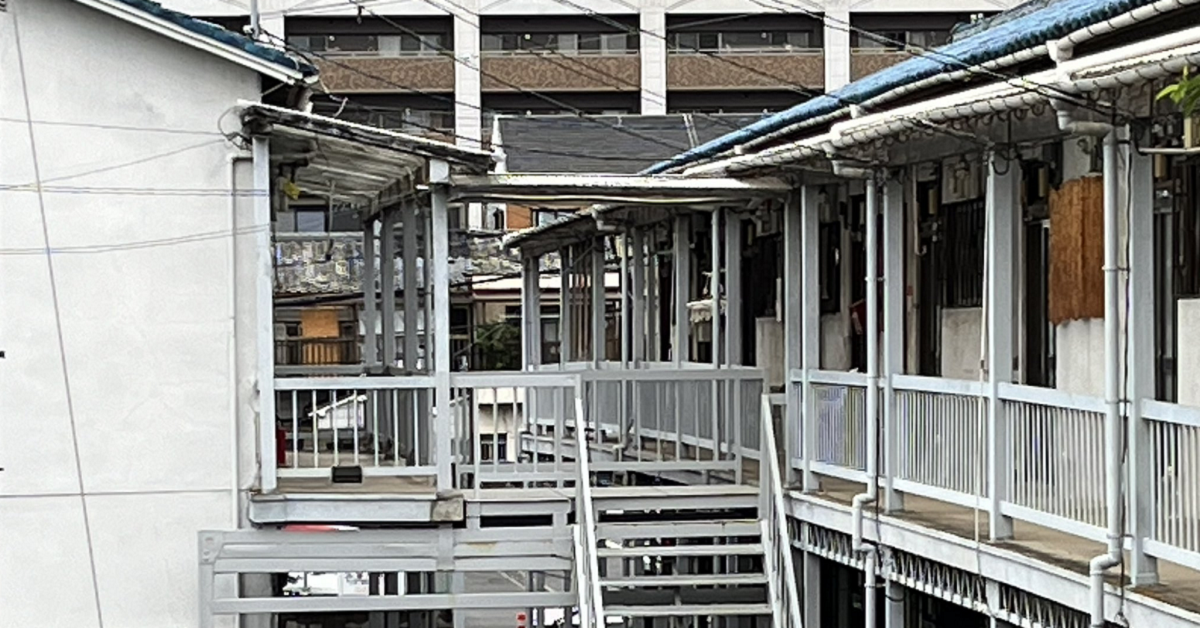The Ando Bunka Jutaku in Osaka, featured in the film “Kokuho”, is a quiet space that seems to preserve the memories of the Showa era. Its wooden structure exudes warmth and humanity, offering a rare glimpse of life now fading from modern streetscapes. Through the exterior of Harue’s apartment, we uncover the emotional depth and timeless spirit woven into the film’s world.
The Ando Bunka Jutaku as Seen in the Film “Kokuho”
Ando Bunka Jutaku is a two-story wooden apartment complex built in the 1950s in Osaka. Its aged wooden walls, narrow alleyways, and small shared spaces evoke a bygone era of close-knit communities. In the film, the building serves as Harue’s apartment and also appears in scenes that connect Kikuo’s childhood and adulthood, creating emotional continuity throughout the story.
| Item | Description |
|---|---|
| Name | Ando Bunka Jutaku |
| Location | Osaka Prefecture (exact address undisclosed) |
| Structure | Two-story wooden tenement |
| Scenes Featured | Harue’s daily life, Kikuo’s memory sequences |
| Built | Around the 1950s |
| Features | Narrow alleys, preserved wooden textures, authentic Showa atmosphere |
The Emotional Atmosphere Created by the Exterior
The exterior of Ando Bunka Jutaku radiates timeless nostalgia. Its weathered wood, rusted gutters, and the sounds of daily life within narrow streets give it a vivid sense of realism. Unlike modern buildings, this structure conveys human warmth and connection. The setting feels as though it breathes—a living portrait of Japan’s Showa-era neighborhoods.
Scenes such as Harue hanging laundry or children playing at dusk bring to life the image of “the Japanese hometown.” Every visual element, from flickering lights to rain-dampened steps, captures the modest beauty of ordinary life.
| Exterior Feature | Emotional Expression |
|---|---|
| Aged wooden walls and narrow paths | Closeness among people and lived intimacy |
| Rain-soaked stairs and eaves | The passage of time and transience of life |
| Light spilling from windows | A symbol of family ties and hope |
The Symbolism of Harue’s Apartment
Harue’s apartment represents her inner strength and solitude. Though humble and worn, it holds traces of a life lived with quiet resilience. The creaking stairs, faded walls, and small windows serve as visual metaphors for time, struggle, and perseverance.
Cinematographically, the lighting plays a key role: the soft afternoon sunlight through the window symbolizes peace and contentment, while the sound of rain at night reflects isolation and emotional renewal.
| Cinematic Element | Implied Meaning |
|---|---|
| Light through windows | Hope and calm happiness |
| Creaking stairs | The weight of memory and the continuity of life |
| Rain on outer walls | Pain, loss, and introspection |
Cultural and Architectural Significance
As a representative postwar residential style, the Bunka Jutaku (Cultural Housing) of Osaka symbolizes the resourcefulness of ordinary citizens during Japan’s reconstruction period. Buildings like Ando Bunka Jutaku were designed to maximize space while fostering community—places where cooperation and daily interaction thrived.
Although many such structures have disappeared due to redevelopment, their value as historical and cultural artifacts is now being rediscovered. They stand as living records of Japanese urban history, representing not only architecture but also collective memory.
| Architectural Feature | Cultural Meaning |
|---|---|
| Wooden tenement structure | Symbol of postwar recovery housing |
| Shared corridors and courtyards | Representation of neighborly ties |
| Handcrafted materials | Testimony to artisanship and local identity |
There is a growing movement to preserve or repurpose these buildings. By reimagining them as film sets or cultural spaces, they continue to live on as “living heritage,” bridging the past and the present through art and memory.
Kikuo’s Flashback Scenes and the Building’s Role
In Kikuo’s flashback scenes, the Ando Bunka Jutaku becomes a vessel of memory and time. The creak of wooden doors, sunlight reflecting off the walls, and the faint sound of a radio immerse the viewer in his emotional recollections.
The building serves not merely as a backdrop but as an extension of the characters’ inner worlds. Its silence and permanence mirror the characters’ intertwined pasts. Through recurring shots of the apartment, viewers embark on a journey through memory, sharing the nostalgia and quiet sorrow of the protagonists.
| Visual Motif | Cinematic Effect |
|---|---|
| Contrast of light and shadow | Expresses emotional ambiguity and remembrance |
| Fluttering curtain in the breeze | A symbol linking past and present |
| Sound of quiet streets | Reflects the inner stillness of the characters |
The “Osaka Spirit” Embodied in the Building
Behind Ando Bunka Jutaku lies the essence of Osaka’s warm and communal culture. The closeness between neighbors, the exchanges of greetings at the eaves, and the hum of life from nearby shops—these details reflect the identity of the city itself.
Even as modernization transforms Osaka, areas like this retain their human warmth. The building embodies the living connection among people, a value deeply rooted in local tradition. Thanks to its appearance in the film, the community surrounding the site has also begun to appreciate its heritage anew.
Conclusion
Ando Bunka Jutaku is more than just a film location—it is a stage for life itself. Within the world of “Kokuho,” it symbolizes human strength, memory, and resilience. The building’s weathered walls tell stories of countless lives, turning an ordinary dwelling into something eternal.
Each detail—the creaking wood, the flickering lights, the soft evening air—speaks of the beauty found in imperfection. Through this film, audiences rediscover the essence of Japanese living and emotion, preserved in the texture of its walls and the rhythm of its spaces.
In every sense, Ando Bunka Jutaku stands as a quiet monument to Osaka’s spirit and Japan’s cinematic heritage, connecting generations through memory and meaning.






